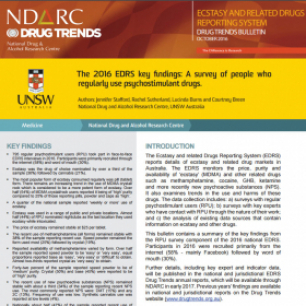Key findings
- 795 regular psychostimulant users (RPU) took part in face-to-face EDRS interviews in 2016. Participants were primarily recruited through the internet (58%) and word of mouth (30%).
- Ecstasy was the drug of choice nominated by over a third of the sample (36%) followed by cannabis (21%).
- The most popular form of ecstasy consumed regularly was pill (tablet) form. There remains an increasing trend in the use of MDMA crystal/rock which is considered to be a more potent form of ecstasy. Over half (54%) of MDMA crystal/rock users reported it being of ‘high’ purity compared to 25% of those reporting pills, powder and caps as ‘high’. A quarter of the national sample reported ‘weekly or more’ use of ecstasy.
- Ecstasy was used in a range of public and private locations. Almost half (44%) of RPU nominated nightclubs as the last location they used ecstasy while intoxicated.
- The price of ecstasy remained stable at $25 per tablet. The recent use of methamphetamine (all forms) remained stable with 38% of the sample reporting recent use. Speed powder remained the form used most (25%) followed by crystal (19%).
- Reported availability of methamphetamine varied by form. Over half the sample reported speed powder to be ‘easy’ or ‘very easy’, equal proportions reported base as ‘easy’, ‘very easy’ or ‘difficult’ to obtain. Almost two-thirds reported crystal as ‘very easy’ to obtain.
- Forty-two percent of the sample reported speed powder to be of ‘medium’ purity. Crystal (50%) and base (45%) were reported to be of ‘high’ purity.
- The recent use of new psychoactive substances (NPS) remained stable with about a third (34%) of the sample reporting recent NPS use. The most commonly reported NPS were: DMT (15%) and any 2C (13%). Frequency of use was low. Synthetic cannabis use was reported at low levels (4%).
- Nationally about half (47%) of the sample reported recent use of cocaine. Frequency of use was low.
- The recent use of cannabis remained high (86%) and stable. About a fifth of the sample reported daily cannabis use.
- Recent use of LSD, ketamine and GHB significantly increased between 2015 and 2016, with variation across jurisdictions. The frequency of use remains sporadic for all these drugs.
- There were significant increases in recent use of: nitrous oxide (25% in 2015 vs. 36% in 2016), amyl nitrate (21% in 2015 vs. 27% in 2016), benzodiazepines (32% in 2015 vs. 38% in 2016) and other opiates (14% in 2015 vs. 21% in 2016).
- The recent use of e-cigarettes significantly decreased (34% in 2015 and 26% in 2016).
- Alcohol is the second most commonly used drug among this group with 97% reporting recent use on a median of 48 days (twice weekly).
- About a fifth of the national sample (18%) reported ever having purchased a drug online with 14% reporting purchasing online in the past year.
Download the Ecstasy and Related Drugs Reporting System (EDRS) Key Findings Handout for more detail.


